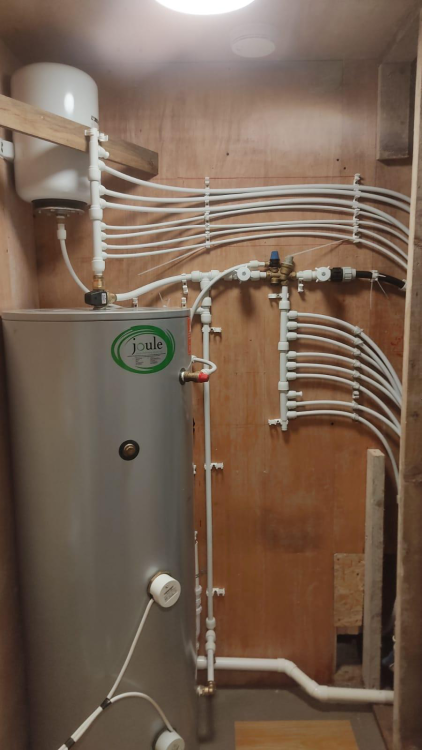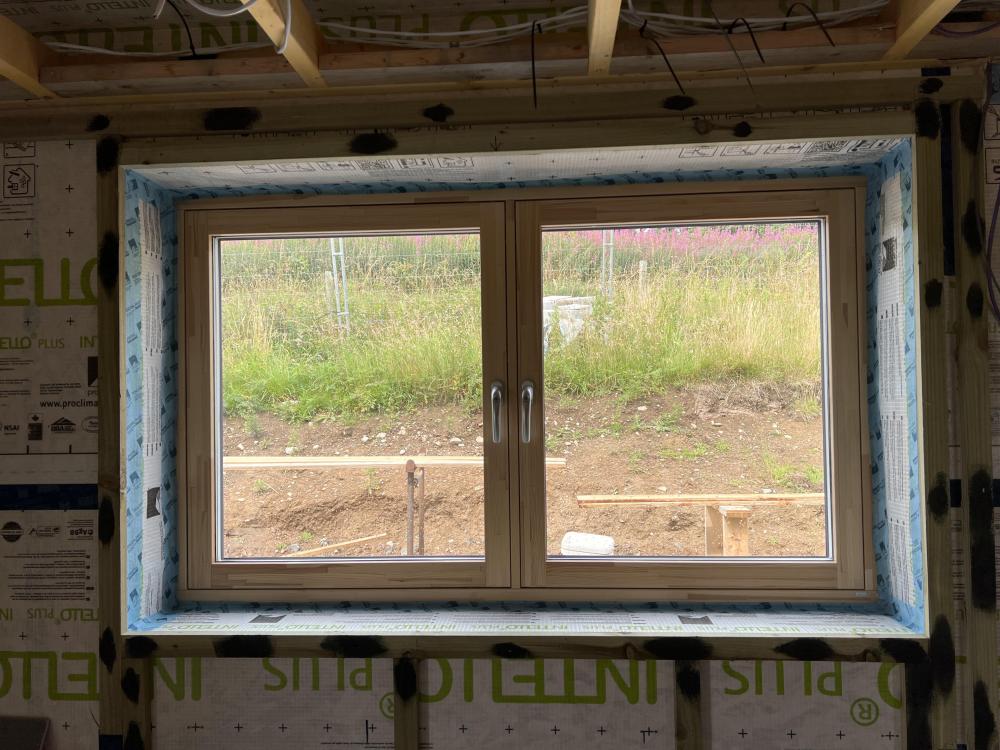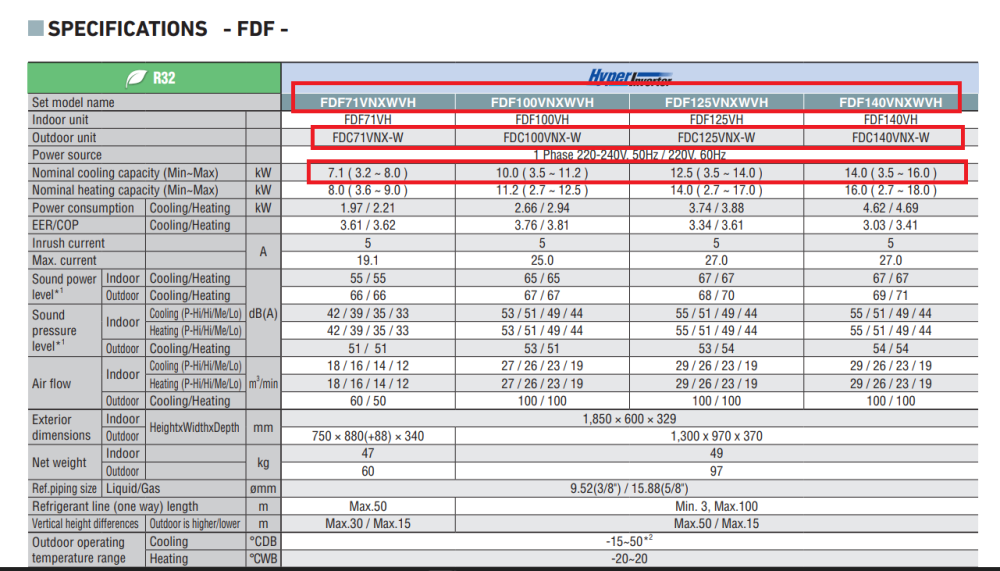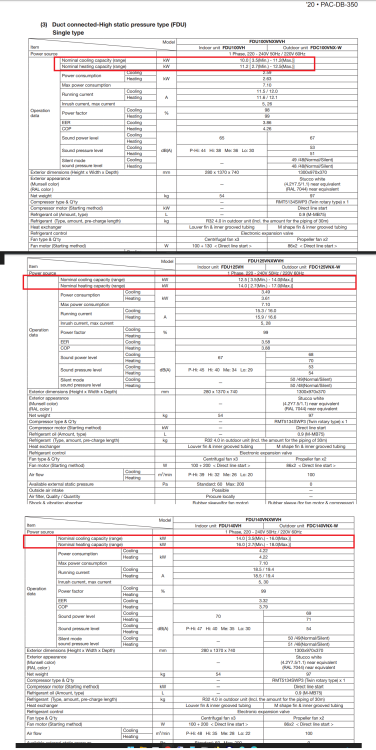Leaderboard
Popular Content
Showing content with the highest reputation on 08/05/23 in all areas
-
Hi Everyone! I've been a long time lurker and have really found the advice and experience of the members in here to start researching and now renovating both my mum's property and eventually my own. I'm about to embark on the first renovation and a rear full width single rear extension for a 3 bed 2001 detached property. I'll be annoying many of you on here on UFH, building queries etc. Thanks! M3 points
-
Why use anything? It will stop any water that does get in from escaping.3 points
-
It's a bodge. I'm not even sure that that grey pipe is underground rated, it's normally orange/brown. I'd take it all out.2 points
-
How far down the planning route are you? If you havent submitted yet, then in all honesty get the land cleared as @joe90 says, you aren't doing anything other than cutting the grass and tidying up! if you make a noise and upset the Wildlife and it goes on a temporary holiday, it'll come back, don't worry about that! What you don't want is wildlife getting in your way, costing you money and delaying you and your journey! That money will be better spent later on, on the things you want rather than paying for some buggers pcp payment on their new land rover. It's all good doing the right things, but in all honesty when you are building every sod and their pal wants their palms crossing with silver just for ticking a box. There's definitely a reason @ToughButterCup 's farmers act like they do.2 points
-
Since starting this build we've had a handy mound of "spoil" from which I have been taking regular photos from the same(ish) spot to remind me of progress during the "down" days which we self builders all suffer from time to time. I thought I'd share this with you. It starts in May 2021, when the major groundworks had been underway for a few weeks and goes up until April this year - about 2 years. First a picture of the mound of spoil for reference: and now the "timelapse": Since that last picture we've been putting on the warm roof structure, so any further photos from this vantage point don't show much sign of progress. so until something significant happens in August this view won't change much1 point
-
I asked MCS that question and they eventually answered that the PD rules were written by, the and the text of MCS-020 approved by, dluhc. So basically they are denying that it's deliberate on their part. I have submitted an foi to dluhc requesting the approval letter, the text to which it refers and some other documents. I await a response which should, if they meet the statutory deadline, come within the next 3 weeks. Meanwhile I have written to my MP (Conservative) asking her how the government defends creating a closed shop which stifles innovation and restricts supply, and other related but less 'loaded' questions. I await the response. I will summarise both on the ashp forum when and if I get them. It would be good if others do likewise.1 point
-
The hole was from the plumber during investigation. That part of the pipe just happened to be exposed because we dug a trench for an electric cable recently. I dug up everything else today. Wouldn't surprise me considering what the previous owner has done elsewhere. Worth mentioning however that I am in Germany so grey pvc pipe for outdoor burial is common.1 point
-
If you only intend to have 100mm insulation in total, I would keep my money in my pocket, by not doing UFH. The downward heat loss will empty your pockets for ever more. Your heat loss downwards is based on UFH flow temp and the ground temp. So say 36 deg flow temp and 6 deg ground temp., So you have a delta of 30 deg. If you had radiators the room temp and ground is used to find the delta T, so 21 - 6 is 15. Heat loss is based on the floor U value multiplied area, multiplied by delta T. So everything else being equal, the downwards heat loss is double with UFH compared to radiators, because the delta T is double with UFH compared to radiators.1 point
-
Here's a diagram of mine.. And a Pic. Things I would change..... On @Nickfromwales advice avoid compression fixings of Hep2o pipes although I've had no issues yet. The Multiblock heats via convention from the thermostatic control valve (screwed directly onto the top of the tank) as it is higher than the top of the tank. This should be lower. Note the hot manifold and the 10mm pipes with the first draw off. It is preheated via convection and there's super speedy hot water to the basin taps. I only insulated the hot manifold as the Hep pipes contain almost no water and it cools instantly once switched off in any case with or without insulation. I should have tanked the floor and put in a floor drain too. I could have ran 10mm cold to the W/C cisterns and the basin taps too but fittings and manifolds were cheaper for the 15mm.1 point
-
1 point
-
1 point
-
1 point
-
1 point
-
Oh no you won’t 🤣 (Christmas is coming, eventually, like summer), bring it on, remember there is no such thing as a stupid question, stupid is not asking. We have all “been there, done that” so lots of real world advise not salesmen BS.1 point
-
No ours is a "boat bath" with no feet. Trap fits between bath and floor. We find we get a lot of fluf and dust down between the bath and wall but it only gets cleaned back there once or twice a year.1 point
-
+1. Despite quite liking tech I fail to see the benefit of it in most applications in a house. Most of it seems to massively over complicate previously simple tasks or harvest as much data, audio and video of you (and your kids and your neighbours) as possible. I like our robot vacuum and the robot lawnmower(when it was installed)but that can be plugged out and thrown away and won't affect the lights or heating. Tech additions I would like to see. 1. Central locking. 2. A washing machine that separates cloths, selects the correct wash for each and returns them dried in a tidy stack. 3. An external sweeping robot to keep driveways and foot paths clean like a robot hoover. 4. A dishwasher that would empty itself into the cupboards. 5. A window cleaning robot.1 point
-
F-gas course is 5 days and if you do c&g it never expires. I’m going to do it later this year.1 point
-
Can get an 'evergreen' F-Gas course here, about a grand. https://fgasregister.com/f-gas-training/ There is new legislation about the right to repair coming in. https://www.bbc.co.uk/news/business-56340077 The biggest issue, as usual in the UK, is planning law and implementation. You can forget all the rest, until that is sorted, it will be impossible to install ASHPs in too many locations. The Government has a target of 600k/year, but last year we installed 60k, bet most were on new developments.1 point
-
I would not bury a p trap in a concrete floor with no wriggle room to fit the bath, why not use a bath trap https://www.screwfix.com/p/mcalpine-bath-trap-white-40mm/84362. Above slab, short length of 40mm pipe then 90’ bend down into concreted pipe work, far more flexibility and you are able to change/clean the trap in future. Also with this you don’t have to sweat about accurately placing the under slab pipe work.1 point
-
Ours came with a (damaged) foam gasket sheet that I replaced with one cut from this.. 3mm white.. https://www.ebay.co.uk/itm/Closed-Cell-polyethylene-foam-sheet-1M-x-1M-insulation-waterproof-rigid-strong/352142516963?var=621587385445&pageci=3c4533a5-13fb-485b-9a3a-4be9e8c36d2d&redirect=mobile It's not a hard foam, more like medium rubber, but felt similar to the one supplied and more durable. After tightening up the bolts I used a sealer same as others did above. It's easier to do before fitting the seat..1 point
-
Good point. MVHR ventilation gaps under doors can undo a lot of good work. For the study/TV-room, I am going to move the ventilation gap from underneath the door to a new grill-vent through a cupboard in to a quiet neighbouring corridor. The door will be a snug fit.1 point
-
I’ve been spending a lot of time in Northern Europe for work this year. Air-air units installed on balconies of flats seem popular.1 point
-
R290 a2a doesn’t require any certification iirc. As long as the refrigerant charge is sub 900grams. Apart from the fact that the uk will end up looking like the back streets of Changhai, with a box hanging off the wall, I don’t think there’s anything holding the technology back apart from chronic lack of understanding by most people about how good they are.1 point
-
Insulation of pipe work is in building regs too, for the same reason1 point
-
1 point
-
How many Passivhaus have you worked on? In the PHPP it requires the insulation levels for hot water pipes. The last thing you want in a PH is heat being introduced into areas where it's not wanted especially in the summer.1 point
-
Or possibly the "real world" this is the real solution to the mass roll out of heat pumps. Easy to install, not expensive, no piss poor CoP to worry about. Competitive price wise with a normal boiler. Issue is general public perception, they think Aircon, expensive to run and cooling only.1 point
-
Keep in mind, the A/W albeit limited in modulation, it runs in a range where the COP is at its best. It might even be designed as such. The A/A is free to use the whole range, but the portion toward the maximum is at a lower COP that rated(10kW). Always look at the output data of the unit for the -5..-7..-10C it is lower than rated a 7C. This is an example from the Vaillant A/W of two sizes using the same unit, with the extra compressor speed modulation at the top, putting out the extra power. Yes with A/A is always like that, the rated label matches the cooling rated capacity1 point
-
1 point
-
A couple mandatory requirements wouldn't go a miss All new builds to have electric only heating and DHW. End user chooses or architect (in most cases). All planning applications will only be approved with install of minimum insulation levels, and removal of any carbon based boiler system. If you don't want to do that, then all your planning applications will be refused. A simplified permitted development criteria, a simplified noise limit and placement guidance. No need for planning unless on a site of historic importance (they would be exempt from all the above and have their own rules and regs). No VAT on the purchase of electric driven heating equipment or heat pump specific cylinders. This includes standalone purchases or as part of an install package. A 50% tax rate + VAT on all non electric heat appliances and all cylinders without a prescribed coil area. Gas, LPG, biomass and heating oil price uplift to 50% of electric price per kWh. So 30p for electric, 15p for gas, heating oil, biomass, LPG per kWh. Option for DHW heating, via immersion and existing cylinder; Willis heaters are cheap and easy to retrofit to any cylinder, or replace with heat pump suitable cylinder. Electric Tariff available for either option. After that the market would sort it's self out. Remove £5k or £7.5k (Scotland) grants.1 point
-
Check the data book https://www.hrponline.co.uk/media/pdf/a5/7f/f2/20_PAC_DB_350_Data_book.pdf Keep in mind the 2:1 modulation you read about is from the air/water hp topics, the A/A has to deal only with 20C air in which the refrigerant has to condense, whilst the A/W refrigerant has to condense in range of temperatures from 20 to 50 ish. Thus make it impossible for the A/W to use the whole range modulation of the compressor/refrigerant pressure. The 10-12-14 kW A/A discussed here have the same compressor, basically being the same double fan unit. The data sheet says it's minimum can be 3kW. Before anything else you should focus only on a proper professional heat loss calculation, only then look for quotes. Without that it's like trying to put a V8 in a Mercedes A class. So what do you have A, C, E, S class?1 point
-
We installed MVHR even though our house isn't as air tight as recommended. I've no idea if it saves us money and it does use slightly more electricity than we expected. Would I fit one again? 100% yes. None of our previous houses had such a system and all had condensation issues of some sort. Our first few nights in the new house felt like we were camping out under canvas the air was so fresh when waking up. Towels dry quickly in the bathroom so haven't needed the heated towel rail. We dry all clothes on a rack in guest bathroom, don't use tumble dryer or outside line. We also don't have to dust surfaced do frequently. Your experience may vary but we think it's one of the best decisions we made. Just make sure the filters are easy to access and ideally washable as we find they need cleaning every few months. You should see all the muck and bugs they keep from coming in.1 point
-
Sod the compression fittings ..! 3/4x15mm Hep2O with some PTFE Tape/ paste in each connection and do up tight then run 15mm Hep2O pipe up to the valves. Nothing needs to be 22mm1 point
-
1 point
-
My favourite is Rocol Gas Seal of all things. Works excellently at lubricating the threads / filling the valleys and is almost completely non-setting. The jet blue / boss white stuff isn't bad TBH, but I don't find it smears as well unless you've put quite a bit on. Always dismount compression stuff after final assembly to remove any excess product from the interval bore of the pipe / fitting or just be VERY sparing when applying.....a little goes a long way1 point
-
Make your life easy... https://www.plumbnation.co.uk/site/hep2o-male-adaptors/?gclid=CjwKEAjwxurIBRDnt7P7rODiq0USJADwjt5Dzd74qVsfugO8BwtyxI7Qkj7_rsSfRlHQ-6nGj87-sRoCLULw_wcB Hep2O HX29 in various sizes, screws straight into the brassware and makes it push fit.1 point
-
0 points




















